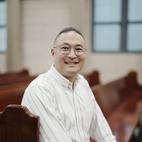Among all the old churches in Beijing, the Holy Saviour's Cathedral on Tonglinge Road, Xicheng District, has its own unique features. It is a combination of Chinese and Western cultures.
In 1862, British Anglican missionaries John Shaw Burdon and Samuel Isaac Schereschewsky came to Beijing to preach the gospel. Together they translated the Bible, published The Book of Common Prayer, and established the first church in Beijing. With the development of Anglican church structure, the North China diocese was founded in 1880, with the bishop of the diocese located in Beijing.
The Holy Saviour's Cathedral was originally the private residence of Yin Keting, an official who worked in the Criminal Department of the Qing Government. At the beginning of the 20th century, the bishop of North China, Charles Perry Scott, liked this place and tried his best to purchase the land and build a church there. In 1907, the church was officially opened, becoming the main Episcopal church in northern China and home to the Anglican bishop.
In the early years of the Republic of China, after registration with the Beijing government, the buildings and land of the Anglican Church officially became the property of the Chinese Anglican church. The architectural style of the Church of the Saviour represents the retro style of Beijing churches in the 20th century. The architectural materials of the church are black bricks and grey pantiles, which give it the charm of traditional Chinese architecture. The church is skillfully fused with the cultural environment of the ancient capital of Beijing.
The layout and structural details of the church are typically European. The layout of the building is double Latin crosses. The north-south main axis of the building adopted a Basilica design. There are two horizontal wings running from east to west, with a larger one in the south and a smaller one in the north. At the intersection of the north-south main axis of the church and the two east-west wings, there are Chinese octagonal pavilions which function as bell tower and skylight of the church. It reflects the integration of Chinese and Western culture. The architecture is an example of the Sinicization of Christianity.
The gate of the church is in Chinese style, with inscribed tablets on both sides and the top. The right part is "the hall of God", the left part is "the gate of heaven", and the horizontal tablet has the words "respectable and august". On the front wall of the church, there are four steles which give witness to past history. The first stele was erected in 1918 in memory of the chairman of Chinese Episcopal church, Berisha. The second one was set up in 1928 by all the believers in the north China diocese. It is set up in memory of bishop Charles Perry Scott who founded the church. The third one is a monument to Francis Lushington Norris, erected in 1946. The fourth one is a memorial to the return of Hong Kong to China in 1997, made possible by the Saiweng Information Company. The four steles represent different time periods, a whisper of past history to those who come to visit the church.
The internal structure of the church is also a model of the unification of Chinese and Western architectural styles. The foundations are in typical Chinese architectural style, with wooden columns and trusses to support the roof load and wooden floors laid on the ground. The altar is set up before the church plane cross. The altar is also made of wood, and is surrounded by Chinese annatto fence, which is carved with flowers and grasses. Behind the altar there is a Chinese style ice lattice partition. The altar furnishings are all traditional Chinese annatto furniture.
After the 1950s, the Anglican church withdrew from mainland China and the church ceased to be used. In the 1990s, the Saiweng Information and Consulting Center carried out the renovation process to restore the old building on the principle of "repair the old as the old". In 2003, the church was listed as a cultural relic protection site in Beijing.
The Cathedral is now a bookstore that allows people to savor the charm of the old church while enjoying the pleasure of reading.












